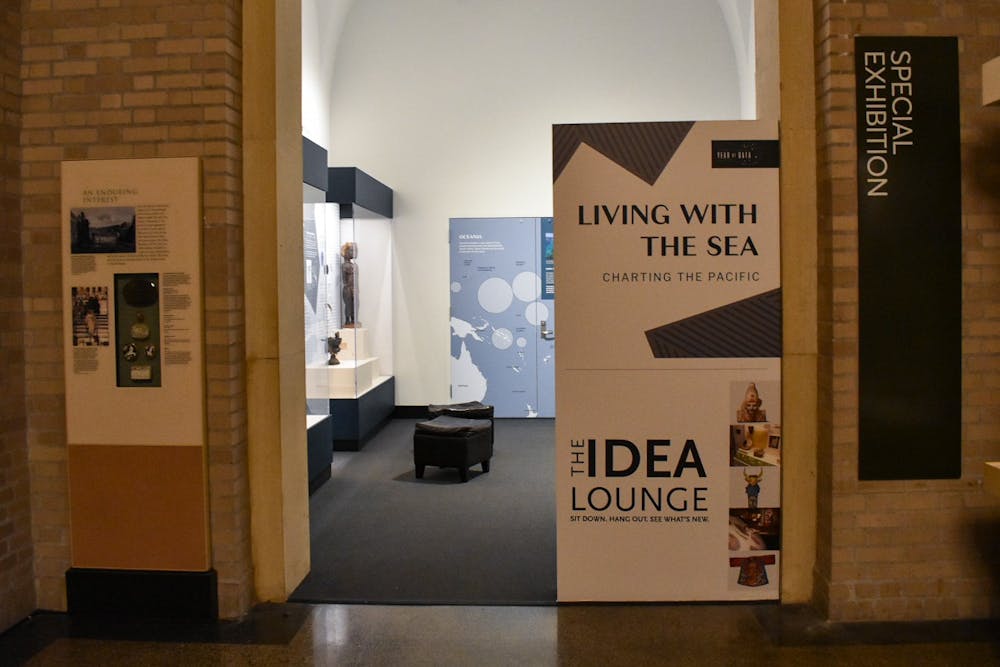
Three Penn students curated a new exhibit in the Penn Museum that explores how the sea has inspired the lives and cultures of Pacific peoples.
The exhibit, titled “Living with the Sea: Charting the Pacific,” was curated by College senior Kia DaSilva and 2020 College graduates Ashleigh David and Erin Spicola. The exhibit, which opened on Aug. 28, is “an exploration of how Oceanian peoples of the historical and archaeological past have interacted with the sea" shown through 14 Pacific artifacts, DaSilva said.
Oceania is a geographical area consisting of thousands of islands in the Central and South Pacific Ocean. The exhibit displays artifacts from the Penn Museum’s Oceanic collection with a focus on the Marshall Islands, a small chain of islands in the Central Pacific. Spicola said that the oceanic environment has led its peoples to create “ways to manage their environment that are really unique to the area.”
Most of the items are on display for the public for the first time. They include sea-based objects such as a “stick chart," a navigational chart that utilizes wave refraction patterns. The exhibit also features an interactive experience created in collaboration with an animation class in the Weitzman School of Design which uses stop-motion animation to tell the story of an Oceanian myth.
The students' exhibit was facilitated by the Student Exhibition Internship, a paid, year-long undergraduate program offered by the Penn Museum that aims to give students curatorial experience. The program selects three undergraduate students each year to work with museum staff to create a small exhibit.
“[The Student Exhibition Internship] is one of the best places within the University to gain curatorial experience,” Anne Tiballi, the museum’s director of academic engagement, said. She said the program offers a unique, behind-the-scenes view of a major museum and an opportunity for students to “create something that is really theirs."

Tiballi added that the program is a great starting point for a career in museum work.
“We have had quite a number of our graduates who participated in the Student Exhibition Program go on to programs in museum studies, museum exhibition design, and graduate work in academic disciplines that are related to their Penn undergraduate degree,” she said.
This is true for Spicola, who is currently pursuing a master's degree in Museum Exhibition, Planning, and Design from the University of the Arts in Philadelphia.
“Going into [the Student Exhibition Internship], I knew I wanted to do something in a museum, but I wasn’t sure what, specifically,” Erin said. “But through the process, I learned that I prefer design over content. It was an incredible experience.”
Marie-Claude Boileau, a Classical Studies professor and lab coordinator for the Center for the Analysis of Archaeological Materials, served as an advisor for the students. This year was her first time working with the program.
“The exhibit was tied into the Provost’s Year of Data, and as an archaeological scientist, I’m very interested in data," Boileau said. She assisted the students by bringing data-focused archaeological approaches to the Oceanic collection, but she insists that she was just a guiding figure.
“Really, the show is all about the students. They did all of the work," Boileau said. "They did their research on the story, the objects, and they made the decisions throughout working with the exhibit team. That this has been completely done by students at the undergrad level is really remarkable. They’ve done amazing work.”
Originally supposed to open in March, the exhibit’s reveal was postponed in light of Penn’s COVID-19 shutdown. The exhibit is set to be open until at least February.
The Penn Museum is currently open Tuesdays through Sundays from 10 a.m. — 5 p.m. Capacity is limited due to the COVID-19 pandemic, and admission is free for all Penn students.
The Daily Pennsylvanian is an independent, student-run newspaper. Please consider making a donation to support the coverage that shapes the University. Your generosity ensures a future of strong journalism at Penn.
Donate



